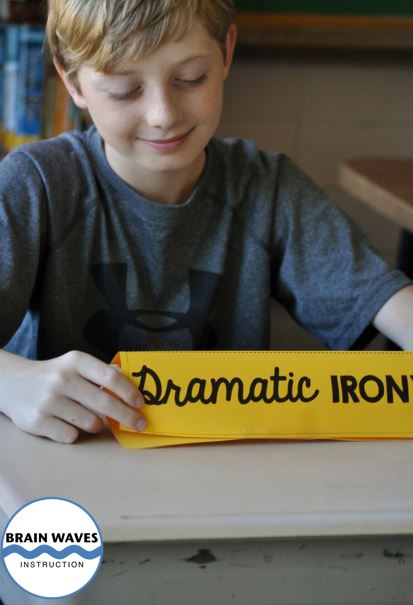Have you ever been faced with a classroom full of blank or even confused faces when you ask students to find, discuss, or analyze the irony in a piece of literature? I know I have! Irony seems to be one of the concepts that students struggle with year-after-year. That's why I thought it was time to develop some hands-on and engaging lessons to get students mastering situational, verbal, and dramatic irony! I thought I'd share some of the ideas with you today. I hope they'll help your students get excited about irony, too!
IDEA #1: Irony Hunt
Send students on a search for irony with this fun activity. First, you'll need to create a set of irony cards. I've found 12 cards to be the perfect amount. On some of the cards write down situations that are truly ironic. Then, on other cards write about situations that are not ironic...maybe just bad luck. Then, create a sheet where students can record whether or not each card contains irony. I like to include a section on the worksheet where they can explain their answer, too.
Next, place the cards around the room. I copy two sets so that students can easily spread out while completing the activity. For an extra fun challenge, you can actually hide the cards. You could tape some under desks, behind the door, above the windows, or inside the class novel. Of course, you don't actually need to hide them. You can also put them in plain sight for students to easily find.
Then, instruct students to find and read all 12 of the cards. After they read each card have them note whether or not the situation is ironic.
Students love this activity because it gets them out of their seats. It's also a great way to get students thinking about irony.
If you're looking for a set of cards already created for you and your students, you can find them in my Irony Mini-Unit resource.
IDEA #2: Irony Flip Cards
Students love making simple irony flip cards. All they need to do is fold a piece of paper in 3 sections lengthwise. Then, have students label each section with a different type of irony: situational, dramatic, and verbal. Next, have students add a little piece of tape so that they create a flip card that they can rotate in response to irony clues that you read to them.
Speaking of irony clues, you'll want to prepare at least 15 irony clues to read out loud to the class. I like to keep them pretty short like: "There is an outbreak of roaches in a pest control office." I also like to use examples from books or stories that we've studied. For instance, since we read My Brother Sam is Dead in class, I might write one clue that says: "Mr. Meeker sympathized with the British, and then he died at the hands of his allies."
Speaking of irony clues, you'll want to prepare at least 15 irony clues to read out loud to the class. I like to keep them pretty short like: "There is an outbreak of roaches in a pest control office." I also like to use examples from books or stories that we've studied. For instance, since we read My Brother Sam is Dead in class, I might write one clue that says: "Mr. Meeker sympathized with the British, and then he died at the hands of his allies."
After students have their flip cards ready, and you have a set of clues, you're set to do the activity. Just read the clues and have students flip their cards to display which type of irony is in each example.
As an extension, you could challenge students to write a few ironic situations themselves. Then, they could read them to the class while their peers flip their cards.
Don't worry, I have a set of clues and even a flip card that's ready for students in my irony mini-unit if you'd prefer to skip the prep and get right to the teaching.
IDEA #3: Irony Foldable
I've found that foldables are incredibly motivating for students. Students get a little giddy when I bring out the scissors and glue sticks...and I can't blame them. Hands-on activities are always the best! That's why this final idea is always a hit with students.
First prepare a set of shutter cards with the beginning of an ironic situation on one side of the shutter cards. For instance, you might write, "Your team wins the championship and your couch says..." Then, have students finish the situation on the other side of the shutter cards. Students might write, "You guys should try much harder next time."
Once students have written the ending for 3 ironic situations, have them cut apart the shutter shapes and glue them onto a piece of paper so that the shutters open in the middle.
Finally, have students explain why the situation is ironic under the shutter shapes.
The end result is a pure demonstration of students' understanding of irony.
There you have it, 3 easy and fun ways to teach irony. The coolest part is that once students have completed these lessons, they actually retain their learning. There's nothing better than hosting discussions about irony during the next literature unit. No more blank or confused faces. Just a whole lot of hands in the air!
I hope you've found some ideas that might work in your classroom. If you're looking for more, then this 3-Day Irony Mini-Unit might be what you need. Not only are these activities ready for you and students, there's also a ton of instructional lessons. Guided notes, reading passages, writing activities, and so much more!
Thanks so much for stopping by!
Mary Beth
P.S. You can find a ton more FUN literary devices mini-units in this bundle. Just click HERE to learn more.















No comments:
Post a Comment